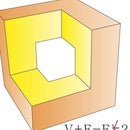Introduction: WolframAlpha Polyhedron - Rhombic Hexecontahedron
This is a fairly simple polyhedron model.
Even a child (from 9 years old) can cope.
The model will become a real decoration of the desktop, especially for fans of mathematics.
You will need:
1.five sheets of standard size paper
2.scissors
3.glue
4.about 1-hour free time.
To assemble a polyhedron, you need to download a shaped net.
Print the shape net on five A4 sheets.
For work, we immediately chose to design double-sided paper in red.
Step 1: Preparation for Assembling a Polyhedron
For convenience, it is recommended to draw the fold lines with a
ballpoint pen. This will speed up the bending process of the flaps. To draw fold lines, you will need a pen, a ruler, and a few sheets of plain paper to create a soft-surface lining. The ball on the tip of the ballpoint pen, drawing a line, creates pressure on the paper and pushes it slightly. The resulting fold line is quite comfortable. But, if you wish, you can refuse this stage of work and go straight to the next one.
Each detail should be cut along the contour using ordinary scissors.
Step 2: Assembly of Each Module
Then we bend all the flaps inward.
We glue each part as shown in the figure.
You should have 20 identical parts.
Step 3: Assembly of a Polyhedron.
1. We glue the parts together through the side triangular surface. An example of two pieces glued together.
2. We glue the third part.
3. We glue two more parts and get a base of five parts.
4. We turn the base over.
5. We glue five more parts.
6. We glue five more parts.
7. We glue four more parts.
In the final stage, we glue the last 20th part.
We get the finished model of the polyhedron.
Step 4: Polyhedron Properties.
This polyhedron gained particular popularity after the Wolfram|Alpha project team made it a registered trademark and symbol of their product.
The www.wolframalpha.com project itself is a set of algorithms that
allow solving mathematical problems and finding answers in databases. Some people compare it to search engines like Google or Yandex. But the creators of the Wolfram|alpha project adhere to a different point of view, that this is an algorithm that allows you to translate a request from a human language into a format convenient for computer processing. It is also believed that Wolfram|alpha is one of the prototypes of artificial intelligence.
The author of the project, Stephen Wolfram, wrote a very detailed story about how the polyhedron - the rhombic hexecontahedron - became the symbol of his product.
https://writings.stephenwolfram.com/2018/12/the-st...
Also, Stephen Wolfram describes the polyhedron model in detail and takes a long excursion into history. He also gives various options for manufacturing a polyhedron model, including from shape nets.
A polyhedron can be obtained by constructing a stellated form of a simpler geometric solid of a triacontahedron.
Recall that the polyhedron triacontahedron is a geometric solid of thirty rhombuses. Each rhombus has a golden ratio. Now let's get back to how to get a stellated rhombic triacontahedron (or rhombic hexecontahedron). If on each of the thirty faces in the form of the initial solid we construct rays in two rhombuses, then the final combination of 2x30 rhombuses will give us a 60-sided facet polyhedron - a rhombic hexecontahedron.












